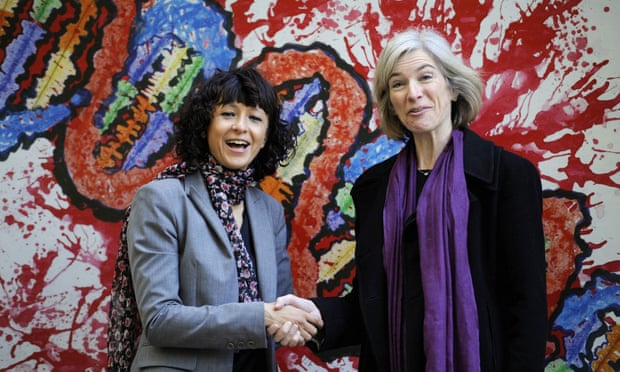Two scientists have been awarded the 2020 Nobel prize in chemistry for developing the genetic scissors used in gene editing – the first time two women have shared the prize.
Emmanuelle Charpentier and Jennifer A Doudna will share the 10m Swedish kronor (£870,000) prize announced on Wednesday by the Royal Swedish Academy of Sciences in Stockholm.
The researchers won the prize for “the development of a method for genome editing”, according to the formal citation from the Nobel committee.
Cheaper, faster and more accurate than other gene editing tools, the harnessing of the CRISPR-Cas9 system has revolutionised the field of genetic engineering, with its impact felt across biomedical research, clinical medicine, agriculture and wider society. However, it is the technology’s potential to treat or prevent human diseases that has generated the most excitement, as well as controversy over attempts to use it to create gene-edited babies.
Speaking at a press conference after the award was announced, Charpentier said she hoped their success would inspire young scientists, regardless of their gender, and demonstrate to female researchers that their research can make a difference.
She said: “My wish is that this will provide a positive message to the young girls who would like to follow the path of science, and to show them that women in science can also have an impact through the research that they are performing.”
“I’m over the moon, I’m in shock,” said Doudna. “In any area of science there are many people who contribute, and that’s certainly true of CRISPR. I’m just pleased that the technology continues to be advancing quickly, in many hands throughout the world.”
“I’m proud of my gender,” said Doudna. “I think for many women there’s a feeling that, no matter what they do, their work will never be recognised as it might be if they were a man. I’d like to see that change and I think this is a step in the right direction.”
Prof Charpentier is director of the Max Planck Unit for the Science of Pathogens in Berlin. As so often in science, her landmark discovery came out of the pursuit of a seemingly obscure area of research – in this case, into an ancient system which bacteria use to defend themselves against viruses.
CRISPR – short for clustered regularly interspaced short palindromic repeats – equips bacteria with the ability to recognise genetic sequences which viruses insert into their DNA, and disable them by snipping the DNA with a set of molecular scissors.
Although researchers were aware of this system, Charpentier characterised the components of the scissors, by studying the bacterium Streptococcus pyogenes, which causes tonsillitis, scarlet fever, and other serious human infections.
After publishing her discovery in 2011, she began collaborating with Prof Doudna, a biochemist at the University of California, to try and recreate the molecular scissors in a test tube, as well as simplifying their components to make them easier to use. Once this had been achieved, they set about reprogramming the scissors so that, rather than just snipping RNA (a single-stranded messenger molecule that normally delivers genetic instructions from DNA) from viruses, they could be used to recognise and cut any DNA sequence at will. “They had created programmable genetic scissors,” said Claes Gustafsson, chair of the Nobel committee for chemistry. “There is enormous power in this genetic tool, which affects us all.”
Soon afterwards, other scientists showed it was possible to do this in cells, and then whole organisms. When cells detects the damage caused by the scissors, they try to fix it, often disabling the gene in the process. This can be useful for turning off harmful genes, but other types of repairs are also possible, such as replacing mutated DNA with a healthy section to correct genetic diseases.
Since Charpentier and Doudna began harnessing the scissors in 2012, their use has escalated. Plant researchers have created crops that can withstand mould, pests and drought, while clinical trials of new cancer therapies and techniques for curing inherited diseases are currently underway.
“The genetic scissors were discovered just eight years ago, but have already benefitted humankind greatly,” said Prof Pernilla Wittung-Stafshede of the Nobel committee for chemistry. “Only imagination sets the limits for what this chemical tool, that’s too small to be visible with our eyes, can be used for in the future.”
The technology has also generated controversy, as scientists have tried to use it to correct genetic defects in human embryos. Doudna has previously admitted to worrying about how the technology she helped develop might be used, including even dreaming that Hitler approached her about potential applications. “Global transparency is a key step in ensuring responsible use of the technology in the future,” she said.
– The Guardian





























































